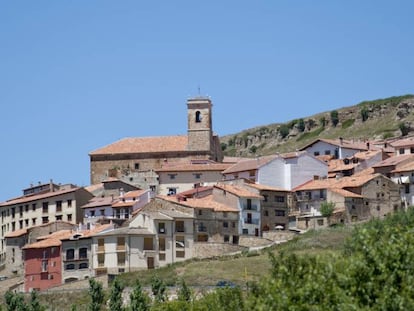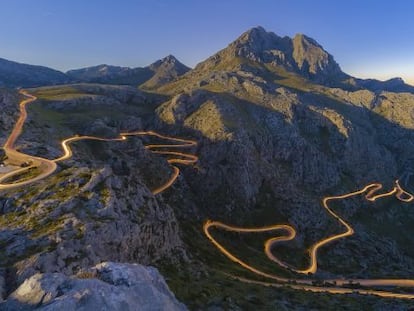Spain’s top 10 bike routes
From the back roads of La Mancha to the splendor of the Pyrenees, the country is a bike lovers’ paradise
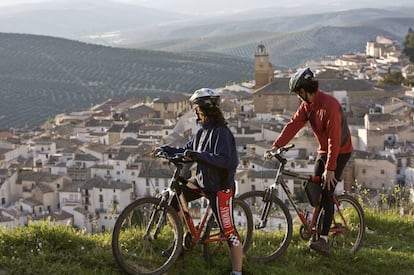
EL PAÍS offers bicycle lovers its top 10 routes for a gentle pedal.
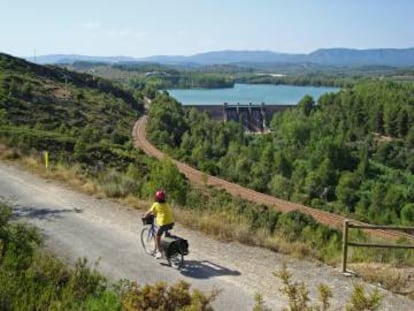
1. Vía Verde de Ojos Negros (from Teruel to Valencia)
The longest of a nationwide network of Vía Verdes (literally, Green Ways) along disused railroads, the Ojos Negros route runs for 160 kilometers in two stages. The first is in Teruel province and passes through the Sierra Menera, while the second descends through the interior of Valencia down to the coast.
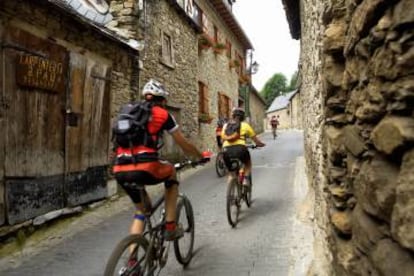
2. The Transpirenaica (from Cabo de Higuer to Cabo de Creus)
This trans-Pyrenees route runs for close to 800 kilometers along the southern slopes of the mountain range, from the Cantabrian coast (Cabo de Higuer, Hondarribia, Irún) to the Mediterranean (Cabo de Creus, in Girona province). Or vice versa. Part of the Europe-wide GR network of footpaths, its distinctive red and white markings have guided thousands of cyclists from around the world through protected areas in the Basque Country, Navarre, Aragon, Andorra, and Catalonia dominated by 3,000-meter peaks and with accommodation available in picturesque mountain villages. The perfect combination of nature, landscape, history, and cuisine.
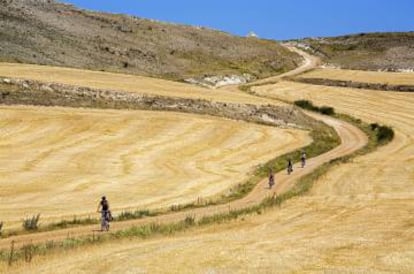
3. The French Way of the Camino de Santiago
Those in the know say the French Way (Camino Francés) of the Camino de Santiago (which runs for nearly 800 kilometers between Saint Jean de Pied de Port, in France, and the cathedral of Santiago de Compostela in northwestern Spain) is the best of the five major Saint James pilgrim routes. It’s easy enough at almost any time of year and offers a tremendous range of landscapes, architecture and cuisine, with any number of historical sites, cathedrals, monasteries, churches, fountains, hostels, restaurants and other facilities.

4. The Vía de la Plata Route
The Via de la Plata Route, a network made up of 26 towns and cities, from Gijón on the Cantabrian coast to Seville, in Andalusia, in collaboration with four regional governments, has set up a bike route (also available on an app), with information and advice for cyclists, along with the best routes for road racers or off-road bikes, as well as a passport that gives holders discounts in establishments along the ancient trade route dating back to before the Romans – the name of which, contrary to popular belief, comes not from the Spanish for silver, plata, but from the Arabic Al-balat, which means paved or cobbled.
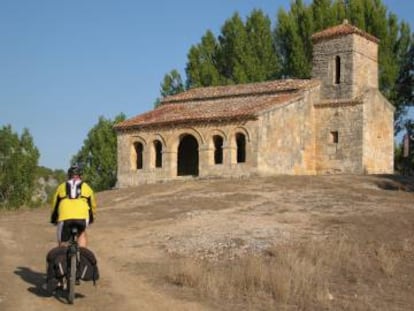
5. The Camino del Cid
“The Way of El Cid is a cultural-tourist route across Spain from northwest to southeast, from Castilla in the interior to the Mediterranean coast. It follows the history and story of Rodrigo Díaz de Vivar, El Cid Campeador, a famous medieval knight of the 11th century and who, together with Don Quixote and Don Juan, is one of Spain’s greatest characters. Unlike the latter two, El Cid is not only a character of literature, but also of history.” So reads the Camino del Cid website, which offers both a road and mountain bike routes along some 1,400 kilometers of pathways and 2,000 kilometers of roads divided into theme-based itineraries running for between 50 and 300 kilometers: The Exile (Burgos, Soria, Guadalajara), The Borderlands (Guadalajara, Zaragoza, Soria), The Conquest of Valencia (Teruel, Castellón, Valencia), along with seven others.
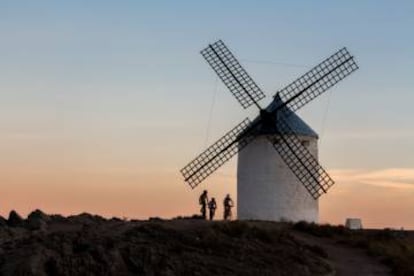
6. The Ruta de Don Quijote (Castilla-La Mancha)
Along the course of its 2,500 kilometers broken up into 10 stages that pass through 148 communities in the five provinces of Castilla-La Mancha, the Don Quijote route takes in the main natural and cultural areas of the region, featuring livestock routes, historic roads, rivers and disused railroads that provide access to more than 2,000 sites of cultural interest. Along the way, there are plenty of the great outdoors activities: birdwatching, the Cabañeros and Tablas de Daimiel national parks, six natural parks, 12 reserves and six micro-reserves.
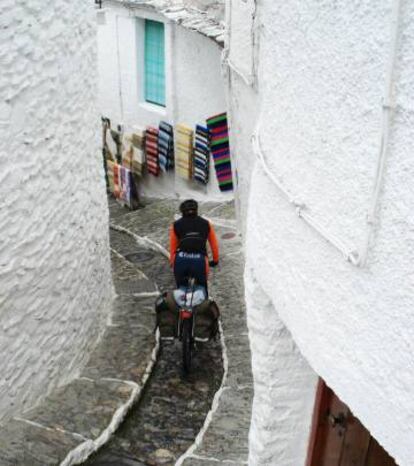
7. The TransAndalus
Conceived as a way to get to know Andalusia’s eight provinces by bike, from the volcanic landscapes of Cabo de Gata, in Almeria, down to the wetlands of Doñana, in Huelva, the TransAndalus is a non-signposted 2,000 kilometer itinerary for cyclists. Some sections include GR paths, while one third of the routes pass through protected areas. This project was set up by cycling enthusiasts in Andalusia who have provided information to build up this ever-growing collection of maps, routes and tracks, all with GPS.
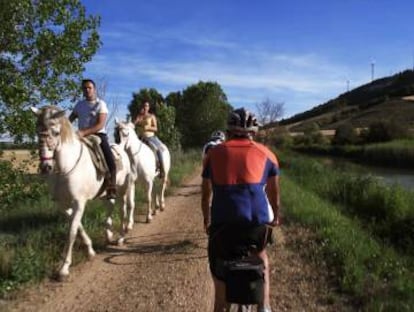
8. The Castilla Canal (Castilla y León)
In the middle of the 18th century a project was begun to transport cereals grown in Castilla y León to ports on the Cantabrian coast via a network of canals, but only 207 kilometers of the so-called Canal de Castilla was ever built. That said, it is a fine example of Spanish hydraulic engineering and very popular with bike lovers. It can also be traveled by foot, horse or by barge. The northern route runs from Alar del Rey toward Calahorra de Ribas, in Palencia province, and from there to Medina de Rioseco, in Valladolid; the southern route runs from El Serrón, in Grijota (Palencia), to Valladolid.
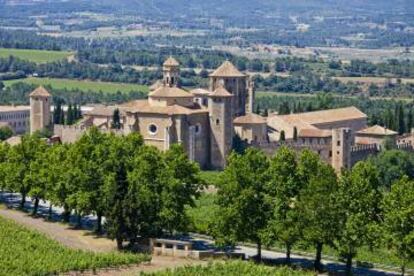
9. The Cister route (Tarragona and Lleida)
The Alt Camp and Conca de Barberá districts in Tarragona, along with Urgell in neighboring Lleida, each have a major Cistercian monastery: Santes Creus, Poblet and Vallbona de les Monges respectively. The GR 175 links the three monasteries: 108 kilometers for cyclists, with four options in the more difficult stretches. This is the backbone of the Ruta del Cister, which includes 65 communities offering not just a rich cultural heritage but spectacular scenery, great wine and food, and lively fiestas.

10. EuroVelo Project: Europe by bike
The Euro Velo Project, a network of 15 long-distance cycle routes connecting and uniting the whole European continent, is due for completion by 2020. Three of the routes are in Spain. The EV 1, or Atlantic Coastal Route which starts on the French border with the Basque Country and ends in Ayamonte, in Huelva province, takes in part of the Via de la Plata and the coast of Portugal. The EV3 links pilgrim routes between Norway and Santiago de Compostela, and the EV8, the Mediterranean Route, starts in Athens and finishes in the Atlantic waters of Cadiz.
English version by Nick Lyne.
Tu suscripción se está usando en otro dispositivo
¿Quieres añadir otro usuario a tu suscripción?
Si continúas leyendo en este dispositivo, no se podrá leer en el otro.
FlechaTu suscripción se está usando en otro dispositivo y solo puedes acceder a EL PAÍS desde un dispositivo a la vez.
Si quieres compartir tu cuenta, cambia tu suscripción a la modalidad Premium, así podrás añadir otro usuario. Cada uno accederá con su propia cuenta de email, lo que os permitirá personalizar vuestra experiencia en EL PAÍS.
¿Tienes una suscripción de empresa? Accede aquí para contratar más cuentas.
En el caso de no saber quién está usando tu cuenta, te recomendamos cambiar tu contraseña aquí.
Si decides continuar compartiendo tu cuenta, este mensaje se mostrará en tu dispositivo y en el de la otra persona que está usando tu cuenta de forma indefinida, afectando a tu experiencia de lectura. Puedes consultar aquí los términos y condiciones de la suscripción digital.
More information
Archived In
Últimas noticias
Maduro pleads not guilty before the federal court in New York: ‘I am still the president of Venezuela’
A new test can detect Alzheimer’s from a finger prick
UN team enters Sudanese city of El Fasher after paramilitary massacre: ‘It’s like a ghost town’
A recipe for resistance: Indigenous peoples politicize their struggles from the kitchen
Most viewed
- Gilles Lipovetsky: ‘If you want to live better and fall in love, take Prozac, don’t look to philosophy’
- Alain Aspect, Nobel laureate in physics: ‘Einstein was so smart that he would have had to recognize quantum entanglement’
- Alvin Hellerstein, a 92-year-old judge appointed by Bill Clinton, to preside over Maduro’s trial in New York
- Why oil has been at the center of Venezuela-US conflicts for decades
- Maduro’s downfall puts China’s relationship with Venezuela to the test

